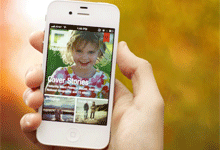The most popular news aggregation app for the iPad launches a new iPhone version Wednesday. Flipboard’s redesign for the smaller screen offers lessons in how publishers should tailor apps for the different needs of tablet and smartphone owners.
If Flipboard for iPhone seems a long time coming, that’s because it is. Flipboard for iPad debuted more than 16 months ago, and the iPhone app had been expected sometime in September.
“It’s something that people have been asking for for a while, and we really wanted to get it right for the iPhone,” Flipboard co-founder Evan Doll told me. “It’s not just a matter of the smaller size, it’s the fact that the iPhone is used in an entirely different context from the iPad.”
How different? Smartphone users fire up their devices in many different places, throughout the day, for a few minutes at a time. Tablet users are using their devices at home, in the morning and evening, in fewer, longer sessions.
Any news app maker will face similar challenges in designing apps for these different devices. They can learn from some of these ideas that went into Flipboard for iPhone:
Commit to portrait orientation. Flipboard changed the signature page flipping interaction to a vertical gesture for the iPhone, instead of the horizontal, book-like page turning on the iPad. This makes a lot of sense when you consider that iPhone users commonly hold the device upright in one hand, unlike iPad users who usually use both hands and often hold the devices horizontally.
Use intuitive or invisible navigation. The last thing you want to do on a small screen is waste space on a bunch of navigation buttons. Flipboard for iPhone fills the entire screen with the images and text the user wants to see. It often uses swipe gestures instead of buttons. The app has hints to show how it can be used; for instance, the bottom half of the welcome page flutters up a bit to show it can be flipped to enter.
This results in a markedly different experience than for most news apps, with their ever-present navigation bars and menus. Flipboard gets out of the way and lets you immerse yourself in content.
Eliminate scrolling. Flipboard opts to break up content into discrete pages that you flip through one at a time, rather than one long page to scroll through. Scrolling has a higher mental and physical burden, especially on a small screen — you have to note where you left off, push the page upward a little, check if you went too far, then relocate your place in the text. Flipping is easier — read the page, swipe, keep reading — no precision or memorization required.
Save users as much time as possible. On the iPhone, users probably don’t have 20 minutes to meander through their streams of content. They have five minutes in line, or between meetings. Enter, Flipboard for iPhone’s “cover stories.”
This new feature curates the few items from a user’s social networks and content feeds that she is most likely to enjoy. Cover stories are based on what content a user has read and shared over time, as well as what her friends have posted, liked or retweeted. This feature will eventually make it to the iPad app as well, Doll said, but time-starved iPhone users were the inspiration.
That ties in to another time-saving Flipboard feature, the “all timelines” view. For power users who connect multiple social networks like Facebook, Twitter, LinkedIn, Instagram and Tumblr, this section merges everything into one stream. Again, this saves the mobile user time by not requiring them to open as many as eight different social apps to check these streams.
Overall Flipboard seems to have made smart decisions with this release, which should extend one of the signature iPad news apps to many millions more iPhone users. Other things to watch:
- Publisher partnerships. This larger market reach is probably good for the Flipboard Pages program, in which dozens of major newspaper and magazine publishers are letting Flipboard embed their content and sharing revenue.
- Rethinking smartphone ads. Just as the iPhone app itself was delayed to “get it right,” Doll said the company is waiting to perfect an innovative ad system. The iPad app helped popularize the full-screen interstitial ad, treating ads as ”beautiful” content instead of gaudy banners. Expect something similar for the iPhone app.
- Other platforms. With iPad and iPhone checked off, the natural next step for Flipboard would be Android. “It definitely gets a lot easier now that we’ve solved some of these smaller-screen design problems,” Doll said. “It’s reasonable to expect that Android would be the next thing we’re looking at, but it’s not set in stone.”
- The big picture. Other iPad apps like Zite, Pulse, Editions, Livestand and, any day now, Google’s Propeller app, will compete with Flipboard. And each of the aggregator apps poses some form of competition or collaboration for the news organizations creating original content. Watch this fast-growing field to see how each player balances efforts to create value for readers, give credit to publishers, and make money for itself.









Comments